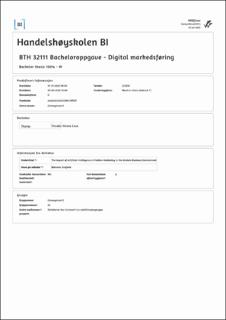| dc.description.abstract | With digital technologies like AI having gained attention due to their ability to connect businesses at a global level, the fashion industry has slowly begun to adopt the technology despite using traditional marketing approaches for decades (Edit, 2020)
The increment in customer awareness coupled with the evolvement of new online as well as offline fashion shopping mediums has changed the traditional decision-making process of customers. However, despite the fashion sector being one of the most dynamic, there is limited use of AI techniques that have the potential to capture data and use it to conduct operations in the sector. The low rate of adoption is due to the fact that most fashion marketers lack adequate knowledge on how they can leverage AI to understand customers’ shopping patterns, price awareness, rate of impulse purchasing, and product exposure to increase the competitiveness of their organizations (Giri et al. 2019). As a result, this thesis seeks to address the above gap by exploring how AI can be used to understand the shopping journeys of both online and offline customers with a specific focus on impulse buying.
The study’s main aim was to determine the precise factors that triggered impulse purchases of fashion products in physical and online stores. The specific objectives that the research intended to address include exploring how AI impacted the decision-making process of consumers in the fashion sector, finding out the role of AI in determining the extent to which customers were exposed to different products and their prices as well as its overall impact on impulse purchasing, and determining the future of fashion marketing as a result of adopting AI. Further, the main hypotheses that the study sought to test include; AI helped marketing personnel the fashion sector to appreciate the distinctions in customer behavior, AI helped marketers to recognize the extent to which customers were aware of the prices of fashion items, AI had a positive impact on the level of planning in fashion marketing and that AI was vital in helping to comprehend customers’ shopping patterns as well as their rate of impulse buying. The study adopted a quantitative methodology where questionnaires were the main tools of data collection.
The research results showed that AI collected suitable data about customers and used it to profile the customers and recommend fashion items that matched their preferences, thus increasing the probability of impulse purchasing. Further, it was also unveiled that AI helped customers to compare the features and prices of related items as well as give recommendations on how newly designed outfits could match, which jointly increased the likelihood of impulse purchases.
Moreover, it was evident that AI’s ability to gather data on such parameters as the purchase duration of customers and their rate of interaction made it possible for marketers to use personalized marketing and consequently increase impulse purchases. All the hypotheses were accepted in the research, and further investigation on the possible negative implications of AI was proposed.
Keywords: artificial intelligence, impulse purchases, price awareness, planning, shopping habits. | en_US |
